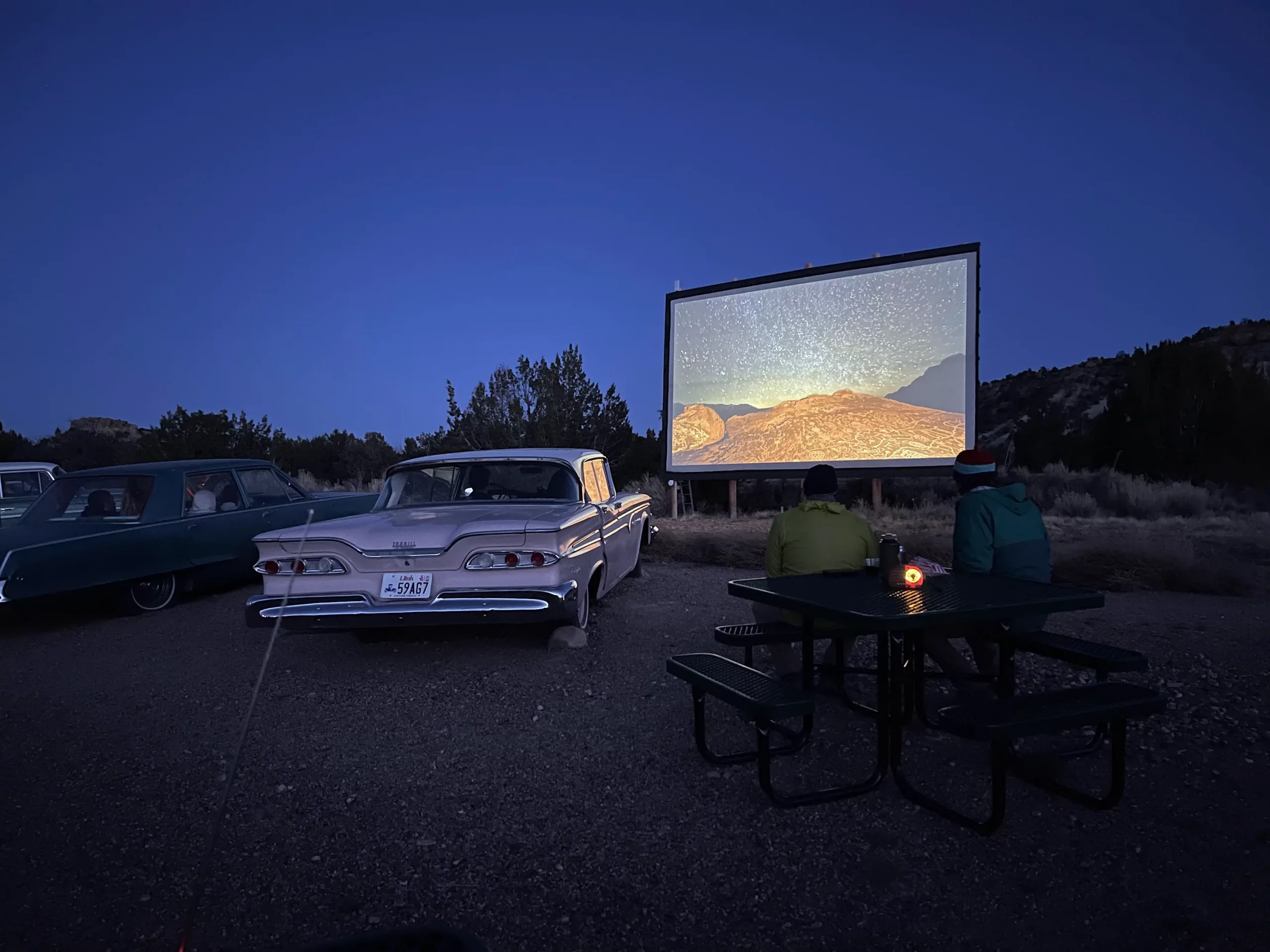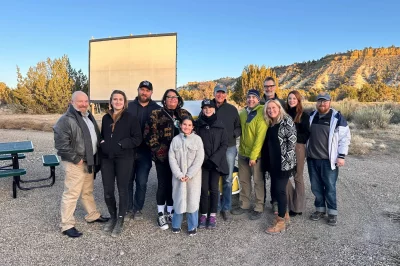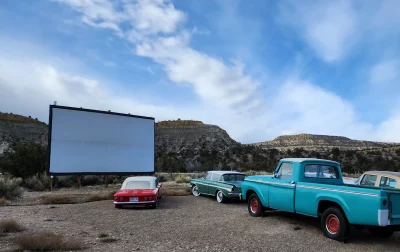
Western Skies: Toohoom-pai-ahv Premieres at Ofland Escalante
Film
On the evening of April 8, just hours after the solar eclipse dazzled parts of North America, I had the opportunity to travel to Ofland Escalante to attend the inaugural screening of a new, short documentary film called Western Skies: Toohoom-pai-ahv (The Southern Paiute Sky).
Ofland Escalante is a 20-acre, outdoor-oriented hotel located 20 miles south of Escalante, Utah—a prime dark sky destination. The property boasts A-frame and deluxe cabins, vintage airstream trailers, personal firepits, a food truck and a one-of-a-kind drive-in theater. The accommodations at Ofland Escalante are incredible, but the theater is the real gem on the property. It successfully recreates an experience reminiscent of days gone by. First-come, first-serve seating is offered in approximately a dozen permanently-parked vintage cars. Audiences watch vintage black-and-white ads of singing sodas and dancing popcorn while waiting for the movie to start. Concessions, including adult beverages, are offered for sale inside of a vintage trailer. It’s the coolest environment to see any film, but especially for an intimate film premiere.

Funded by Ofland Escalante, Western Skies: Toohoom-pai-ahv is packed full of historical, cultural and scientific information about the night sky and its cultural significance to the Southern Paiute tribe in southern Utah. The film premiered on their drive-in big screen followed by an intimate, behind-the-scenes discussion with some of its creators and night sky experts.
“I initially got involved with the project to advocate and raise awareness to those outside of indigenous communities to understand that TEK [or Traditional Ecological Knowledge] serves a purpose in STEM and Westernized science,” says Autumn Gillard, a maternal descendant from the Cedar Band of Paiutes of the Paiute Indian Tribe of Utah (PITU). Gillard is an astronomer and Southern Paiute dark sky expert who is prominently featured in the film. I had the privilege of briefly meeting her before the screening.
“A hesitation that I had was the issue of cultural appropriation and exploitation of cultural knowledge,” says Gillard. “Many times, individuals outside of Indigenous communities take cultural knowledge and mold it into something of its own. Ultimately, I felt that it was important to place the Southern Paiute Nation in a position to inspire others [about] the beauty and understanding of the night sky.” Watching the film screened under the dark night sky in Offland’s drive-in theater, I felt this inspiration. I felt a sense of wonder, mystery and spiritual connection to the stars.
“It has been long overdue that society learns about the true nature of the Southern Paiute people from an academic, Southern Paiute perspective,” says Gillard. “I also wanted to leave something for our younger generations to learn from and be proud of who they are as Nuwu people.” The Nuwuvi, or Nuwu, refers to the Southern Paiute people of southern Nevada, northern Arizona and southern Utah. Western Skies: Toohoom-pai-ahv educates travelers staying at Ofland Escalante on the star-mapping work of the local Southern Paiute tribal nation and offers a glimpse of what they can experience themselves in the surrounding night sky.
“I had heard that there was an Indigenous community in southern Utah and northern Arizona that had made strides in mapping out the constellations and planets centuries before Galileo, and without the use of telescopes or other optic tools,” says Deven Nongbri, the executive producer of the film. “The idea of a short film that celebrated that science and educated guests about the history and cultural significance of the night sky of this specific area was born.”
Nongbri pulled together a team of mostly Indigenous filmmakers to get it made and worked with the owner of Ofland Escalante, Charles Tate, to financially back the project. “Our director, Chad Windham, is part Cherokee. All three of the writers on this project are Choctaw or Cherokee. Travis and Poppy, the grandfather and granddaughter in the film, are real-life grandfather and granddaughter and are Southern Paiute,” says Nongbri. “And of course, Autumn and [the film narrator] Daniel Bulletts are Southern Paiute. There are not a whole lot of films being made today where the creative leadership is being driven by Indigenous film professionals. We’re proud of the team we put together to share this story more widely.”

In the film, Gillard mentions the importance of Paiute tribes being the sole record keepers of their history. I asked her to tell me more about that. “It is important for the Southern Paiutes to be their personal record keepers because it is a part of who we are and how we pass cultural information from generation to generation, to always ensure that our history and teachings survive in our own society,” says Gillard.
“Working on this film was one of the most rewarding projects of my career,” says Windham. “It’s given me a new respect for Indigenous science and culture.” Western Skies: Toohoom-pai-ahv will be made available to the Southern Paiute to screen to their community for outreach and educational purposes. Another motivation behind creating the film was the opportunity to acknowledge the Indigenous tribes that previously lived on this land. “We need allies in support. Not advocacy or speaking on behalf of our culture and history themselves, but integrating and elevating our voices,” says Gillard. “This should be a method to raise Indigenous voices in personal areas where individuals live.”
“There was a mutual respect from both the Indigenous writing team and cast and our Western filmmakers. Everyone was open to trying to tie the two teachings together and show how we are all looking at the same sky with the same amount of awe,” says Windham. “We are one people sharing the land, the sky and wonder. This team worked as one to bring this film together.” Western Skies: Toohoom-pai-ahv successfully connects Southern Paiute astronomy with Western astronomical constellations in just under 30 minutes. Jam-packed with stunningly beautiful footage, scientific facts and interviews with knowledgeable experts, the film commands viewers to stop and look up.
If you’re like me, you’re part of the 80% of the world’s population that lives in light pollution. Living in a city where the lights are always on means we’re disconnected from the visible night sky and humanity’s historical connection to it. Luckily for us Utahns, our state is home to some of the darkest skies on earth and we don’t have to go far to experience them.
“With development and light pollution, we are losing our night skies,” says Windham. “The night sky is important to our natural cycle. The dark sky designation of the Southern Paiute land is paramount to protecting this native land and keeping access to an unpolluted night sky.” Since 2021, April has been celebrated in Utah as Dark Sky Month and currently leads the world in dark sky preservation with 25 accredited dark sky international places. They include Natural Bridges National Monument (the first-ever dark sky-designated park in the world), all five of Utah’s national parks, 10 state parks, two towns and more.
I asked Gillard what she wanted those visiting Ofland Escalante to take away from viewing Western Skies: Toohoom-pai-ahv. “I would like others to take away a new appreciation of our universe and new understanding of a culture outside of their own,” says Gillard. “I would also like others to truly engage with their natural environment and night skies.”
Western Skies: Toohoom-pai-ahv will be shown exclusively at Ofland Escalante’s drive-in theater through October 2024. Watch it nightly on the big screen before that evening’s main feature film. For more information on screenings, visit ofland.com.
Read more about local filmmakers inspired by Utah landscapes:
Reclaiming the Native Narrative with Winding Path
Weston Razooli Found Magic in the Uintahs